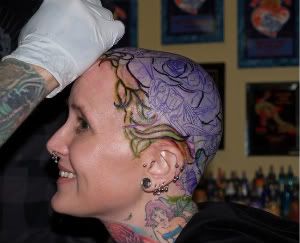Tattoo Advice and History > Tattoo Advice > Placement
Placement
When I first started collecting ink, I was certainly not as mindful of the important concept of placement as I am now. It's fun to want instant full sleeves or to cover that ritualistic "tramp stamp" spot, but are those areas REALLY suited for the shape, size and overall design of that area of your body?

Understanding placement is almost a science in the world of tattoo art. Like when searching for apartments or the perfect house to call your home, you want to be sure that you take the time to research your choices and understand the lasting effects of your placement choice.
Making a tattoo appear its most beautiful means utilizing the contour and shape of each part of your body in the correct way. Just because you want a portrait of your grandma on your forearm, doesn't necessarily mean that the reference fits the spot. It might, but it might not. Which way is the image facing? Will it be distorted if you arm is turned a certain way? Will the area of skin surrounded by existing tattoo work distract from the effect you are after? It may all sound trivial, but placement is very important and something to talk carefully with your artist about. I know this from experience, after using up many key places on my own skin with pieces that were not best suited where they were put. I remember Mike DeVries working for nearly two hours placing and replacing the stencil for my Bjork portrait on different areas of my leg so that her face didn’t look funky when I rotated or stood a different way.
It may all sound trivial, but placement is very important and something to talk carefully with your artist about. I know this from experience, after using up many key places on my own skin with pieces that were not best suited where they were put. I remember Mike DeVries working for nearly two hours placing and replacing the stencil for my Bjork portrait on different areas of my leg so that her face didn’t look funky when I rotated or stood a different way.
There was something about the direction and angles of the piece that made it imperative to get the spot that she sat on JUST right, so that the finished product looked as beautiful as the reference image. We placed the stencil of her, looked in the mirror, switched the spot, looked in the mirror; had other artists give their advice, switched the spot, and so on and so forth. She finally found the perfect location on my leg, but I’ll tell you, it took some work to get her placed correctly.
So my advice to those of you who still have spots open: plan carefully, chose spots wisely and learn about the art of anthropometry (the study of the measurement and proportions of the human body) and the contour of anatomic body shapes. Talk to your artist and brainstorm over what you put where. Try it out, see how it looks and don’t be afraid to move the stencil to another area of the body if needs be. You will be happy that you took that extra amount of time when all is said and done and your tattoo will present itself in the best of ways when it sits in the correct spot.
Last updated on January 16, 2012 by Jinxi Boo




